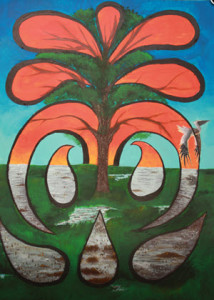
Student April Olivier’s acrylic painting, “Window of Time.” April created this during the CWC Art and Science Camp saying, “In my artwork, I depicted the deterioration of the marsh and land loss over time.” Provided by Murt Conover.
Each summer, parents send their children to camp, trying to match their interests while broadening their horizons. This year, the parents of ten Louisiana students hit the jackpot: the Coastal Waters Consortium (CWC) inaugural Art and Science Camp. This camp challenged participants, engaging both their analytical and creative talents to learn about a locally-relevant and nationally-important subject matter—oiled marsh lands.
For decades, academic institutions have witnessed the arts and sciences compete with each other for funding, recognition, and validation. However, the events at this year’s CWC Art and Science Camp proved that the two disciplines are not only compatible but complementary.
Murt Conover, the Senior Marine Educator for CWC, funded by the Gulf of Mexico Research Initiative (GoMRI), had been thinking about a combined discipline workshop such as this for years. The idea for the camp moved from dream to reality after a local artist, Karen Alice Clanton, approached Conover with questions regarding the Deepwater Horizon oil spill following her attendance at a CWC-hosted Coastal Roots workshop. Clanton, whose work focuses heavily on the Louisiana coast, and Conover soon developed a partnership, organizing a summer camp that emphasized the importance of both art and science as tools for communicating environmental concerns. For Conover, this workshop was a “breath of fresh air” because it was outside the traditional Science-Technology-Engineering-Math (STEM) focus, bringing together artists and scientists and reaching students who are not typically interested in science-related activities.
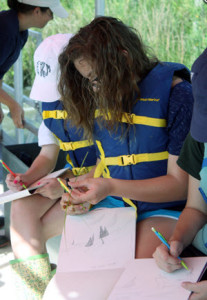
Students created artistic renderings in the field while receiving information from both scientists and artists. Photo by Murt Conover.
The camp took place June 8-11 in Cocodrie, Louisiana, and introduced teenagers to art and science – not as rivals but as allied subjects. The students (ranging from 8th to 12th grade) came from varying backgrounds, some with a noted interest in science and others in art. Students spent their days performing research and experiments about coastal wetlands and then translating what they learned into pieces of art. Upon their arrival, the campers and their parents learned about local professional artists, such as Walter Anderson, from camp instructors and local artists Clanton and Jennifer Koppin. They also heard about GoMRI-funded research that focuses on understanding the impacts of the oil spill on the ecosystems that they would be encountering during the camp. The following days were a melding of science and art.
The mornings began with students going into the wetlands aboard kayaks and research vessels and gathering samples of water, sediment, vegetation, and marine life. They learned about wetlands vegetation and impacts of disasters on them directly from scientists with CWC who are currently conducting research in these areas: Dr. John Marton (marsh biogeochemist at the Louisiana Universities Marine Consortium, LUMCON), Dr. Brian Roberts (marsh ecologist at LUMCON), and graduate student Elizabeth Robinson (studying oil impacts on blue crabs at Louisiana State University). Afternoons consisted of laboratory work analyzing the samples they collected and generating data from them. Then, they went into studios to recreate what they learned through art. Some camp activities included experiences in both disciplines simultaneously.
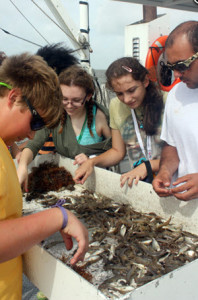
Hands-on science, such as collecting samples of marine life in the marsh, helped students gain a deeper understanding about the science that they later used in their artistic depictions. Here students were on board the RV Acadiana. Photo by Murt Conover.
For example, some boat trips consisted of sketching wildlife while listening to an expert explain the surrounding vegetation and the impacts of pollution on various species. The camp finished on a high note, with students holding a gallery show for their families and staff from LUMCON and CWC.
The art aspect of the camp provided an entirely new method of teaching the students about coastal wetlands. While students had no trouble understanding and learning from their experiences in the field, translating the science into works of art helped them look at the material from a completely different angle, fostering a deeper understand of the information. Conover explained that students would “ask the art teachers about composition one minute and then come to me the next minute asking about the details of the organisms they were drawing, wanting to make sure they were accurate.” As the students developed their artwork, it became obvious that they assimilated their experiences from field work and the lab by the visual imagery they created to share their learning.
The students were extremely enthusiastic about the camp, exceeding Conover’s expectations. One student remarked, “I came for the science, but I really learned a lot about art.” Meanwhile, another student who had attended the camp strictly to create art found that she loved working in the field and expressed that she was now considering pursuing wetlands biology once she entered college.
What began as an experiment to educate students on coastal wetlands through art and science soon became a life-changing experience. The impact of the camp on students and teachers set the stage for future CWC Art and Science camps, opening the door to not only education, but expression.
“Magic happened,” said Conover, “I can’t say it any other way.”
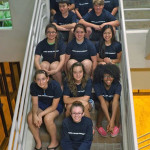

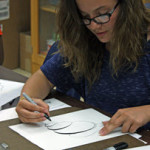
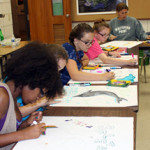
************
This research was made possible in part by a grant from BP/The Gulf of Mexico Research Initiative (GoMRI) to the Coastal Waters Consortium (CWC). The GoMRI is a 10-year independent research program established to study the effect, and the potential associated impact, of hydrocarbon releases on the environment and public health, as well as to develop improved spill mitigation, oil detection, characterization and remediation technologies. An independent and academic 20-member Research Board makes the funding and research direction decisions to ensure the intellectual quality, effectiveness and academic independence of the GoMRI research. All research data, findings and publications will be made publicly available. The program was established through a $500 million financial commitment from BP. For more information, visit http://gulfresearchinitiative.org/.
